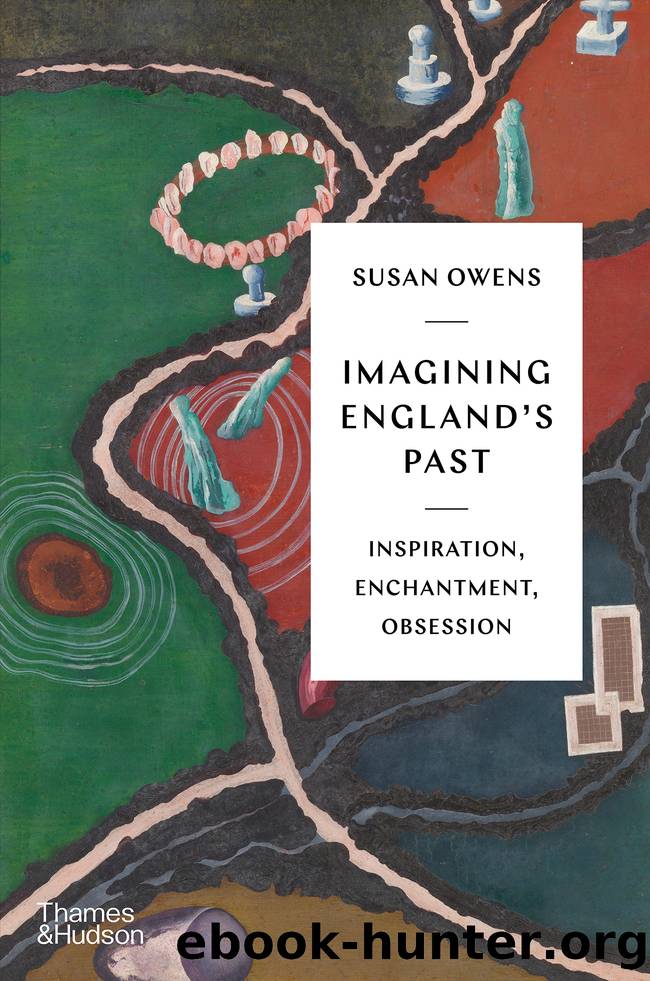Imagining England's Past by Susan Owens;

Author:Susan Owens;
Language: eng
Format: epub
Publisher: Thames & Hudson Ltd.
Published: 2023-09-15T00:00:00+00:00
Self-caricature by Edward Burne-Jones in the studio he shared with William Morris, 1856; brass-rubbings are pinned to the walls.
This withdrawal from the London art scene and shrugging rejection of its agenda was a highly eccentric, potentially career-ending move, and meant that, by the middle of the 1850s, Rossetti was in need of new disciples. He found them in the younger figures of Burne-Jones and Morris, whom he had met in 1856 after Burne-Jones had sought him out. These two friends, who had met as undergraduates at Exeter College in Oxford, had soon discovered a shared love of medieval things and jointly embarked on what they called a crusade âagainst the ageâ.7 After Oxford they shared accommodation in London, eventually settling their books, painting materials, easels, brass-rubbings, old prints and bits of armour in unfurnished rooms in an early eighteenth-century house on Bloomsburyâs Red Lion Square, recommended by Rossetti, who had lived there himself at one time. It soon filled up even more with the heavy wooden furniture (âintensely medievalâ, according to Rossetti) that Morris had commissioned according to his own designs; as a sixteen-year-old, he had so disapproved of the standards of contemporary design and manufacture that he had refused to enter the Great Exhibition when taken there by his family.8 Morris, Burne-Jones and Rossetti regarded this furniture, which included a huge settle, as a blank canvas, and painted it with bold medieval scenes of knights and ladies, some inspired by Morrisâs own poetry.9
Rossetti was focusing with increasing intensity on the long-ago. He declared Maloryâs Morte dâArthur and the Bible to be the worldâs greatest books, and around this time painted his first Arthurian subject of many â a highly charged watercolour representing Sir Launcelot demanding a kiss from Queen Guenevere, now a nun, in front of King Arthurâs tomb. Launcelot leans outrageously, if awkwardly, over Arthurâs recumbent effigy, thrusting his face towards the Queen.10 Rossetti rarely felt any need to faithfully represent a text, even one he considered so great, and had conflated two incidents in Maloryâs text in order to create a bizarrely morbid take on the classic love triangle. For Morris and Burne-Jones, Le Morte dâArthur was every bit as important. They had found a copy in a Birmingham bookshop when they were both still undergraduates, while Morris was staying with Burne-Jonesâs family. Burne-Jones could not afford it and had resorted to reading it piecemeal in the shop, but Morris, who had family money, bought it outright. What they found in its pages was different from Tennysonâs Arthurian poems, âThe Lady of Shalottâ, âSir Galahadâ, âSir Launcelot and Queen Guinevereâ and âMorte dâArthurâ. Offering a seemingly inexhaustible wealth of exciting stories and complex psychological situations, Malory was a vast and unpredictable landscape to Tennysonâs carefully tended garden.
In Oxford, the Union building was so new that you could smell the damp mortar, although it was designed to give the impression of a medieval church. The timber roof was left visible and the architect shaped each end like an apse â the effect is rather like being inside an upturned wooden ship.
Download
This site does not store any files on its server. We only index and link to content provided by other sites. Please contact the content providers to delete copyright contents if any and email us, we'll remove relevant links or contents immediately.
| General | Channel Islands |
| England | Northern Ireland |
| Scotland | Wales |
Room 212 by Kate Stewart(4739)
The Crown by Robert Lacey(4573)
Endurance: Shackleton's Incredible Voyage by Alfred Lansing(4507)
The Iron Duke by The Iron Duke(4122)
The Rape of Nanking by Iris Chang(4023)
Killing England by Bill O'Reilly(3898)
Joan of Arc by Mary Gordon(3784)
Say Nothing by Patrick Radden Keefe(3725)
I'll Give You the Sun by Jandy Nelson(3273)
Shadow of Night by Deborah Harkness(3176)
Hitler's Monsters by Eric Kurlander(3164)
Mary, Queen of Scots, and the Murder of Lord Darnley by Alison Weir(3066)
Blood and Sand by Alex Von Tunzelmann(3057)
Darkest Hour by Anthony McCarten(3018)
Margaret Thatcher: The Autobiography by Thatcher Margaret(2971)
Eleanor & Park by Rainbow Rowell(2943)
Red Famine: Stalin's War on Ukraine by Anne Applebaum(2816)
Book of Life by Deborah Harkness(2720)
The One Memory of Flora Banks by Emily Barr(2685)
